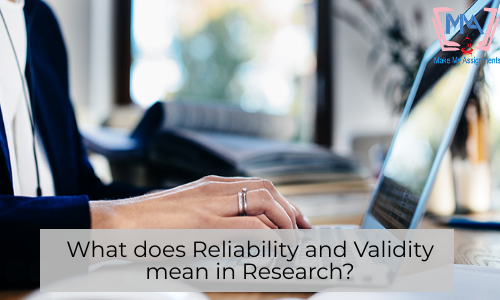
What does Reliability and Validity mean in Research?
For performing in-depth research, reliability and validity are considered to be the two most important aspects that every researcher needs to follow while compiling their project. With the help of these two aspects, they can easily check whether the factors, conditions and assessments of their research are accurate in itself or not.
To know more about these aspects, here we have provided a detailed explanation on both-
What is Reliability?
Reliability for research defines of how consistently a method measures something. In order to find it reliable, the same result needs to be achieved consistently by using the same methods and circumstances.
What is validity?
Under this aspect, it denotes how accurately a method measures what it is attended to measure. When your research depicts high validity, this means that the results obtained correspond to real characteristics, variations and methods in the physical world.
 Types of Reliability in research
Types of Reliability in research
There are four different types of reliability in research, which are as follows-
Test-Retest reliability
This is where you get to measure the consistency of results, often by repeating the same test on the same sample but at different point of time. There are many factors that tend to influence the results at different point of time. This can include your various moods or even external conditions. Therefore, the test-retest reliability is used to assess how well a method is adopted to resist the factors over time.
Internal consistency reliability
Under this type, you assess the correlation between multiple terms in a test, whose main intention is to measure the same construct. Like for an example, you are measuring your customer satisfaction level, for doing that you need to create a questionnaire with various statements that the consumers might agree with or not. This method can also be carried out by repeating the test again and again or involving other researchers in it. The two common methods of assessing reliability under this designation are as follows-
- Split-half reliability
- Average inter-term correlation
Inter-Rater reliability
For measuring the inter-rater reliability, one must follow the degree of agreement between different people, where they are assessed and observed for the same aspect. This comes out to be useful when researchers need to collect data assigning scores or wants to measure the degree of agreement between different people. One of the most common example for this could be measuring the progress of wounded patients in a hospital. Therefore, this aspect is aimed at minimizing the subjectivity level so that different researchers could replicate same results.
Parallel-Forms reliability
For this aspect, you must measure the correlation between two equivalent versions of a text. Researchers use it when they need to have two distinct assessment tools to measure the same thing. The measurement of financial risk aversion in a group of respondents can be used as an example for this theory. And the most common way of measuring the parallel-forms reliability is to produce a large set of questions to evaluate the same thing.
Types of Validity in research
There are four main types of validity in research, which are as follows-
Content validity
It is used to assess whether your test is representative of all aspects of the construct. The contents of a survey, measurement or test method can help cover the relevant parts of the subject, so that the researcher gets to produce valid results.
Criterion validity
The criterion validity method helps evaluate how closely your results of test correspond to results of a different test. For doing this, you need to calculate the correlation between the results of the criterion measurement and the results of your measurement for the test. If you get a high score of correlation, then this indicates that your test is measuring what it intends to measure.
Construct validity
This is where your measurement tool represents the things we are interested in measuring. Therefore, it tends to play a central role in establishing the overall validity of a method.
Face validity
Under this method, you consider how suitable the contents of a test seem to be on the surface. This one is quite similar to the content validity method, but is more informal and subjective in nature. And most often it is considered to be the weakest form of validity because of its assessment being subjective.
If you are still not able to grasp the concept of reliability and validity, then you can take help from our online assignment writing experts, to get the best assistance and guidance in your academic work.





